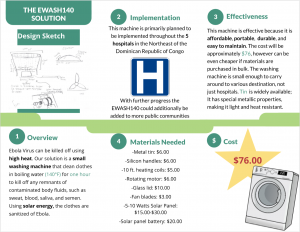Apr
23
2019
Thus far, we have chosen a specific engineering-based solution that impacts Ebola in the Northeastern Democratic Republic of Congo. This solution is a small solar-powered washing machine that can sanitize clothes of the Ebola virus with high-temperature water. Here is some basic research we’ve collected on solar power!
Apr
22
2019
According to the US AID, 70 percent of citizens living in the Democratic Republic of the Congo are without health care or barely have access to it. The DRC used to be known for its healthcare clinic and physicians. Sadly after the wars broke out their medical system declined rather quickly. With their healthcare system in ruins, it is almost impossible to secure the health of the people of the DRC, that is why it is crucial to rebuild their health system.
Ebola is a virus that hit the Democratic Republic of the Congo very hard. Since their healthcare clinics are no longer up to par, many cases of Ebola are going untreated. Hundreds of people are dying because they simply, cannot access hospitals or clinics. The clinics that do exist are not very cleanly and can cause people to leave in worse shape than they arrived.
In the Northeastern section of the DRC, there are only five hospitals and clinics. For a city with over 1.3million people living there, five clinics are not nearly enough to sustain the health of everyone living there. The people in the congo need more health care clinics to ensure the health of their country.
https://www.usaid.gov/democratic-republic-congo/global-health
https://apps.allianzworldwidecare.com/poi/hospital-doctor-and-health-practitioner-finder?PROVTYPE=HOSPITALS&CON=Africa&COUNTRY=Congo_Democratic_Republic_of_the&CITY=Kinshasa&choice=en
Apr
22
2019
After researching Ebola in the Northeastern Democratic Republic of Congo our group members narrowed our solution search down to three idea solutions:
Ebola Virus can be killed off using high heat. One possible solution is a small washing machine that clean clothes in boiling water (140°F) for one hour to kill off any remnants of contaminated body fluids, such as sweat, blood, saliva, semen. The small size allows it to be used in individual households or in healthcare facilities. The energy used to power the machine could be solar power.
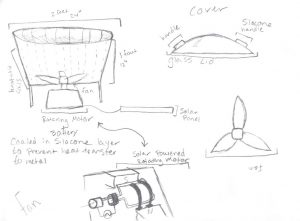
Feces is one of the largest carriers of the Ebola Virus. Healthcare facilities are currently keeping contaminated waste in separate containers and storing it for later transport out of the hospitals. One possible improvement to this system is the implementation of an appliance for feces that seals and heats waste at high temperature or in boiling water to kill/inactivate the virus so that it can be disposed of in a regular latrine. Solar power could be utilized to power the appliance.
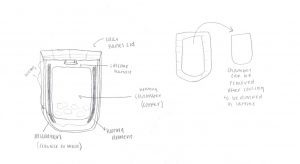
Specific chemicals are known to be able to kill the Ebola Virus, such as bleach, alcohol, chlorine, and ammonia. To decrease the transmission of the virus through body fluids, a body wash/soap with an alcohol content to kill the virus could be used to clean the entire skin surface when bathing/showering (to be used after cleaning with regular soap). The soap would be combined with antibacterial and moisturizing agents so that the skin is cleaned but not completely dried out. This could help decrease the transmission of infected body fluids.
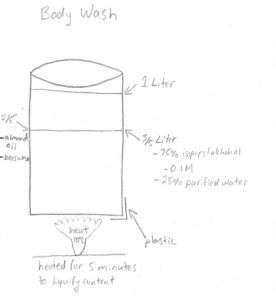
We used the weighted decision matrix below to determine which of the three solutions to use.
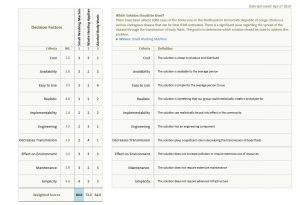
To educate the population about Ebola we have created the following brochure, keep in mind this is a slight draft. Many other additions will be made following the synthesis of our solution prototype. This brochure aims to inform the public Northeastern Democratic Republic of Congo on Ebola and our engineering-based solution to it.
Take a peek:
Ebola Brochure (1)
Apr
15
2019
The problem we chose to address for our project is the major issue regarding transmission of Ebola Virus Disease through body fluids. This includes transmission through blood, feces, vomit, sexual contact, burial of infected bodies, and contact with surfaces contaminated with fluids. The reason we chose this specific problem is because we believe it has one of the most significant impacts on the well-being of at-risk communities. Transmission plays one of the largest roles in the perpetuation of this epidemic and it does not discriminate who it affects. This is an issue that poses a threat to all people of the population rather than just a specific group. We chose this problem because we believe it is one of the largest contributors to the spread of Ebola Disease. Coming up with a way to reduce transmission would lead to a great decrease in the amount of people contracting and dying from the disease, as well as decrease the risk of EVD spreading to other countries. It was important to our group that we chose to address an issue that was realistic for us to solve. Based on this piece of criteria, we determined transmission as a problem with the most realistic possibility of an engineering solution and concluded that addressing this problem would allow us a large range of possibilities in terms of approach.





